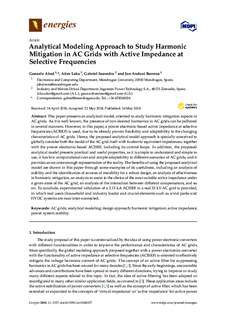| dc.rights.license | Attribution 4.0 International | * |
| dc.contributor.author | Abad, Gonzalo | |
| dc.contributor.author | Barrena, Jon Andoni | |
| dc.contributor.other | Laka, Aitor | |
| dc.contributor.other | Saavedra, Gabriel | |
| dc.date.accessioned | 2018-07-27T14:14:18Z | |
| dc.date.available | 2018-07-27T14:14:18Z | |
| dc.date.issued | 2018 | |
| dc.identifier.issn | 1996-1073 | eu_ES |
| dc.identifier.other | https://katalogoa.mondragon.edu/janium-bin/janium_login_opac.pl?find&ficha_no=147831 | eu_ES |
| dc.identifier.uri | https://hdl.handle.net/20.500.11984/1099 | |
| dc.description.abstract | This paper presents an analytical model, oriented to study harmonic mitigation aspects in
AC grids. As it is well known, the presence of non-desired harmonics in AC grids can be palliated
in several manners. However, in this paper, a power electronic-based active impedance at selective
frequencies (ACISEF) is used, due to its already proven flexibility and adaptability to the changing
characteristics of AC grids. Hence, the proposed analytical model approach is specially conceived to
globally consider both the model of the AC grid itself with its electric equivalent impedances, together
with the power electronic-based ACISEF, including its control loops. In addition, the proposed
analytical model presents practical and useful properties, as it is simple to understand and simple to
use, it has low computational cost and simple adaptability to different scenarios of AC grids, and it
provides an accurate enough representation of the reality. The benefits of using the proposed analytical
model are shown in this paper through some examples of its usefulness, including an analysis of
stability and the identification of sources of instability for a robust design, an analysis of effectiveness
in harmonic mitigation, an analysis to assist in the choice of the most suitable active impedance under
a given state of the AC grid, an analysis of the interaction between different compensators, and so
on. To conclude, experimental validation of a 2.15 kA ACISEF in a real 33 kV AC grid is provided,
in which real users (household and industry loads) and crucial elements such as wind parks and
HVDC systems are near inter-connected. | |
| dc.description.sponsorship | Financiado por Ingeteam | eu_ES |
| dc.language.iso | eng | eu_ES |
| dc.publisher | MDPI AG | eu_ES |
| dc.rights | © 2018 by the authors | eu_ES |
| dc.rights.uri | http://creativecommons.org/licenses/by/4.0/ | * |
| dc.subject | AC grids | eu_ES |
| dc.subject | analytical modeling | eu_ES |
| dc.subject | design approach | eu_ES |
| dc.subject | harmonic mitigation | eu_ES |
| dc.subject | power system stability | eu_ES |
| dc.title | Analytical Modeling Approach to Study Harmonic Mitigation in AC Grids with Active Impedance at Selective Frequencies | eu_ES |
| dc.type | http://purl.org/coar/resource_type/c_6501 | |
| dcterms.accessRights | http://purl.org/coar/access_right/c_abf2 | eu_ES |
| dcterms.source | Energies | eu_ES |
| local.contributor.group | Sistemas electrónicos de potencia aplicados al control de la energía eléctrica | eu_ES |
| local.description.peerreviewed | true | eu_ES |
| local.identifier.doi | https://doi.org/10.3390/en11061337 | eu_ES |
| local.relation.projectID | Aula Ingeteam | eu_ES |
| local.source.details | Vol. 11. Nº 6. 1337 | eu_ES |
| oaire.format.mimetype | application/pdf | |
| oaire.file | $DSPACE\assetstore | |
| oaire.resourceType | http://purl.org/coar/resource_type/c_6501 | eu_ES |
| oaire.version | http://purl.org/coar/version/c_970fb48d4fbd8a85 | eu_ES |








